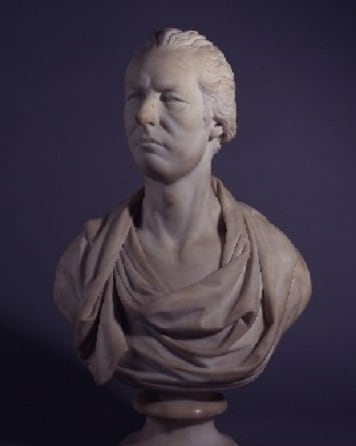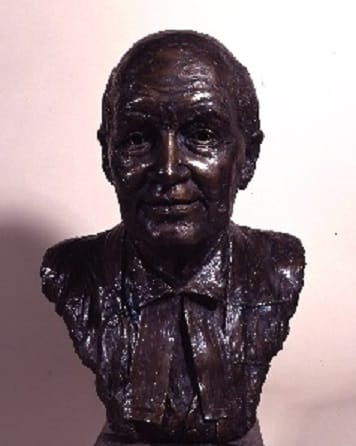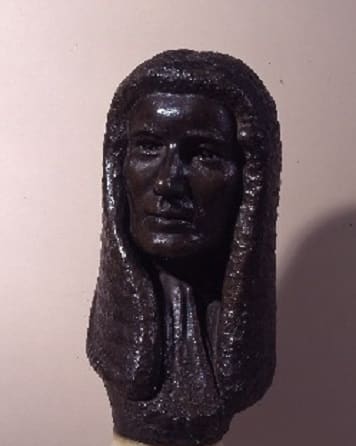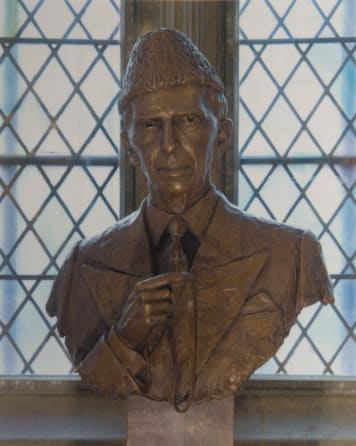September 2019 – Cicero and other busts

On 2 September 44 BC Marcus Tullius Cicero made the first of his political attacks, now known as the Philippics, on his arch opponent, Mark Antony. Cicero is one of the few non-members who are commemorated here at the Inn. In the upper vestibule you will find a bust of this great orator watching over the entrance to the Hall.
The white marble bust stands on a black socle and marble pedestal with a Latin inscription. The wording is a quotation, from Juvenal’s Satire VIII, which eulogises Cicero’s part in foiling the Cataline conspiracy of 63 BC which sought to overthrow Rome’s political leaders. How and when such a piece came into the Inn’s possession is almost unknown. The Black Books are silent as to its acquisition and so we must turn to other sources. A clue can be found in Samuel Ireland’s book Picturesque views with an historical account of the Inns of Court in London and Westminster. In describing the Inn’s library, which at that time consisted of four rooms on the ground floor of 2 Stone Buildings, he states that in “an alcove, at the furthest end of the room, stands a beautiful marble bust of the great Cicero”. Thus, the bust was in the Inn’s possession prior to volume’s publication in 1800. Any earlier provenance, unfortunately, is lost in the mists of time. Experts say that it is a popular type known as pseudo-Cicero and is probably an eighteenth century copy of an ancient bust. It could, therefore, have travelled back from Italy with a member returning from the Grand Tour. The pedestal and quotation would probably have been added later, perhaps to suit its placement here in the Inn.
Cicero is one of twenty-one portrait busts here at Lincoln’s Inn. The smallest one is a mere ten inches high while the largest is over twenty-four inches in height. The majority of these are carved marble or cast bronze but we also have ones made from plaster, resin and brass. Seventeen named sculptors have their work displayed here with William Behnes (1795-1864) and William Theed (1804-1891) being the most represented with two busts each.
Although contemporaries and having the same first name they could not have been more different. Behnes trained as a painter but turned to sculpture and was a pupil of George Frederick Watts while Theed studied under his father, William Theed snr, also a noted sculptor. Both were enormously successful but Behnes died bankrupt and almost penniless due to his extravagant life style. It was said that he had been found unconscious in the gutter with a mere 3d in his pocket and taken to hospital where he died three days later. Theed, on the other hand, died peacefully of old age at his home leaving £40,751 to his family. Both had strong links with royalty with Behnes made Sculptor in Ordinary to Queen Victoria and Theed commissioned by Prince Albert to do several pieces.

In the lower vestibule there is a bust of William Pitt made by William Theed in 1879. It is after the bust made by Joseph Nollekens from Pitt’s death mask. Pitt is said not to have allowed Nollekens a sitting so the sculptor attended Pitt’s death bed and took the mask, on which his bust is based, at the statesman’s demise. Theed’s other bust in the Inn’s collection is one of Sir Francis Goldsmid (1808-1878) which was gifted to the Inn by Goldsmid’s widow in 1879. This bust, standing near the library entrance, commemorates the first professing Jew to have been called to the English bar and then to take silk.
The two busts by Behnes, one signed and one attributed to, are of Lord Brougham (1778-1868) and of Charles Butler (1750-1832), respectively, and are on the dais in the Hall. The latter is the one plaster bust in the Inn’s possession and depicts the first Roman Catholic to be called to the bar since 1688. Butler became a barrister, after having a successful career as a conveyancer, in 1791 after the passing of the Roman Catholic Relief Act. He only appeared in one case, however, concentrating instead on his legal writing.
Female sculptors account for four of the Inn’s works including two of Lord Denning, who is the sitter most represented in this category with three busts. These two both depict Denning, in different ways, when he was Master of the Rolls. The earlier one by Josefina de Vasconcellos (1904-2005), a Brazilian artist, shows him in a full bottomed judicial wig and jabot. It was made in 1969 of resin which makes it stand out from the others as it gives a rather softer, less formal look which mirrors the impression that Denning wished to portray of being accessible despite his high office. The other one, by Jean Roth in 1976, continues this informal theme as his bands are the only sign of his professional status. She was introduced to the judge at a dinner to which she had accompanied her husband, another Lincoln’s Inn member, and the commission followed this meeting.


The only woman to be depicted in this way is Cornelia Sorabji, who was one of the first female barristers. This brass bust, by another female sculptor, Sachidanand Unavane, shows Cornelia in her habitual sari which is partially draped over her head. It sits in the Upper Vestibule and was presented to the Inn in 2012 by Dr Kusoom Vadgama, who had commissioned it for the launch of her biography of this pioneering Indian lawyer. Finally, our newest bust, and largest, is also of a noted overseas member, Muhammed Ali Jinnah. This was presented to the Inn by the Pakistan High Commissioner in 2017 and can be found in the library. This is the only bust which depicts the sitter wearing a hat, in this case his trademark karakul known as a Jinnah cap. The other singular feature of this work by Philip Jackson is that it includes the sitter’s hand holding his monocle.

